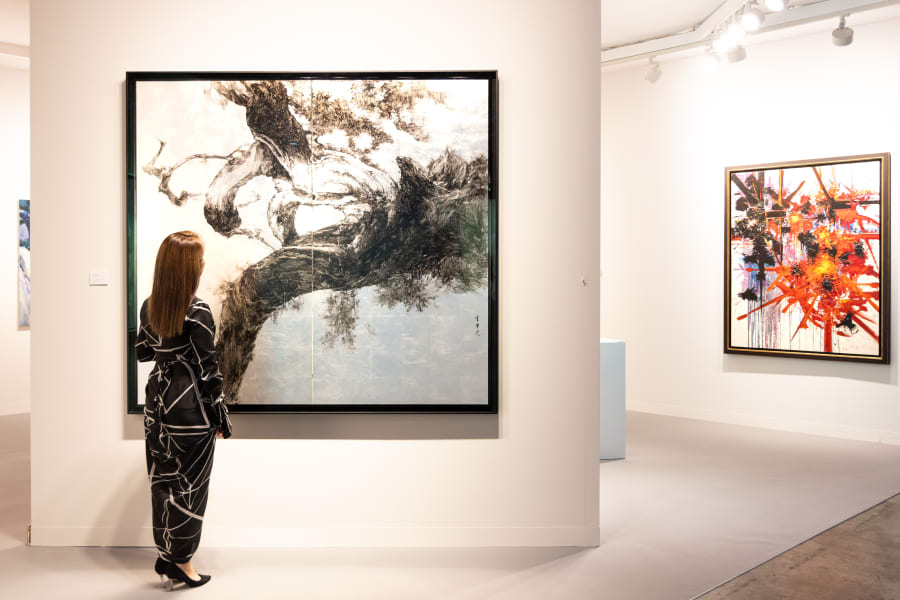A significant proportion of art world professionals believe that 2024 will bring increased or stable online sales, according to The Art Basel and UBS Art Market Report 2024. Of those surveyed, 48% of dealers and 81% of staff from mid-tier auction houses expect online sales to go up this year. But after a 4% drop in the global art market in 2023 to an estimated USD 65 billion, what makes them so confident?
Firstly, the report shows that online sales were up by 7% last year, now accounting for a total of USD 11.8 billion, or 18% of the market. This brings the digital side of the art market in line with other industries (e-commerce accounted for 19.4% of total retail sales worldwide in 2023, according to the data platform Statista). ‘This underlines how this segment of the art business is maturing,’ the report says.
‘One out of every two new clients we meet are online, and this is due to the fact that we really invested in developing our digital channels and programming over the last 7 years,’ says Elena Soboleva, the global head of online sales at David Zwirner. According to The Art Basel and UBS Art Market Report, online sales made up 23% of dealers’ total sales in 2023, up by 7% from 2022, with the biggest growth being through dealers’ own online channels and websites, which accounted for 20%, up from 12% in 2022. ‘Online is now a foundational layer for the gallery, rather than an auxiliary add-on or stand-alone function and, for the gallery, online and offline are no longer distinct entities,’ Soboleva says. ‘Our programming is completely omni-channel as collectors desire a seamless experience.’
This level of infrastructural and staff development in digital in recent years is significantly noticeable in blue-chip galleries such as David Zwirner. In 2020, the gallery hired the management consultancy firm Office of Applied Strategy to create a digital strategy that would position its website ‘as the eighth gallery location,’ including ‘an expanded e-commerce system.’ As well as improving the website to host online exhibitions and display available works, David Zwirner has since launched various online sales initiatives. ‘After several years of transformational change, I think we have evolved into the post-OVR [online viewing room] environment, where digital tools that complement and extend global programming are key to future-proofing a gallery,’ Soboleva says. ‘They allow the art world to have truly global reach.’
But it is not only mega galleries that are reaping the rewards of digital investment. Guts Gallery in London, which was launched in 2019, also recognizes the importance of online sales. ‘We allocate significant resources to our website, catalogues, documentation, and commentary, ensuring that all our staff members are thoroughly trained,’ says Ellie Pennick, the gallery’s founder, and director. ‘This investment has certainly contributed to boosting our sales.’ Pennick adds that social media has been central to the gallery’s growth. ‘Instagram is our most valuable tool,’ they say.
Interestingly, according to The Art Basel and UBS Survey of Global Collecting in 2023, the total spend on art by high-net-worth (HNW) collectors through Instagram dropped from 6% in 2022 to 4% in 2023. However, this figure represents sales of works found on Instagram and purchased directly or through a link on the app to an artist, gallery, or other seller, and previous reports have noted how such platforms are often used more as channels for initial discoveries rather than final sales. The drop of sales through Instagram is part of a wider decline in the popularity of external (as opposed to gallery-owned) online platforms, from being the first choice for purchasing for 17% of collectors in 2022 to just 8% in 2023.
The latest art market report also highlights a notable – if counterintuitive – trend relating to the age of collectors buying online. ‘Unlike the cliché of social media and online channels being favored by younger collectors, these platforms were much more popular with Boomer and older collectors than Gen Z collectors,’ the report says. ‘Boomers and Gen Z collectors in all regions preferred dealers, but excluding art fairs, millennials and Gen X collectors had a higher preference for auctions in 2023.’
Pennick says Guts Gallery has a wide age range of collectors coming through digital channels but that they have ‘observed a growing number of older collectors, including Boomers, reaching out to us via Instagram.’ Soboleva agrees that the picture is mixed. ‘The clients we meet via digital channels are highly global. It is a key entry point for younger collectors, who often come through our prints offering,’ she says. ‘However, to say it only caters to Gen Z would be misleading – not only do the most significant collectors use digital channels to inquire on works, but we regularly have curators of major museums and biennales inquiring online as well. The swift, frictionless digital experience appeals to all.’
‘We do not see any significant difference in buyer demographics between our live and online-only sales,’ says Katerina Blackwood, an associate specialist and head of online sales for Modern and contemporary art at Phillips auction house. ‘In 2023, about one third of our buyers were millennial and Gen Z collectors.’ The Art Basel and UBS Art Market Report shows that Phillips significantly developed its online sales in 2023. (The report classifies online-only sales as those where a live auction does not take place and does not include online bidding at a live sale.) Last year, Phillips online-only sales grew by more than one third (36%) year-on-year to USD 34 million and the number of sales held only online has also grown from 12% of the total in 2019 to 43% in 2023. While this accounts for a relatively small 4% share of total public auction sales values, the figure is up from 1% in 2019. At Sotheby’s, online-only auction sales reached USD 487 million, down 6% on 2022, accounting for 9% of the value of total public auction sales in 2023, and made up 54% of the number of sales held during the year, up from 30% in 2019. Christie’s online-only sales grew by 2% to USD 369 million in 2023 making up a 7% share of total public auction sales values.
Phillips was also successful last year at bringing in new buyers, with a reported 50% of buyers at live and online-only auction channels being new to the company, and Blackwood says that digital channels have helped with that. ‘We do rely on digital marketing both for sale-specific outreach and raising awareness of our brand,’ she says. ‘Many people feel intimidated entering the auction world and making their first art purchase. Because of that, I can see the appeal of getting this introduction online, as it seems that many new clients feel more at ease exploring the art sales for the first time digitally.’
Price points continue to be one of the main factors that determine whether a sale will be online-only or offline. The Art Basel and UBS Art Market Report shows that more than 95% of transactions in online-only auctions were for works priced less than USD 50,000. ‘I think people naturally have less inhibitions transacting below the six-figure range online,’ Blackwood says. ‘One can argue that buyers view art purchases at more luxurious price points as an experience they want to consciously live through, which doesn’t always fit the concept of online-only auctions.’ Huma Kabakcı, a second-generation collector and independent curator, says the price is key in buying online. ‘Without seeing the work, I just wouldn’t pay more than GBP 3,000,’ she says. ‘I think I only exceeded this amount once and it was five figures, but it was commissioned specifically for me and I was in contact with the art adviser online with images of the details. I just need to be 100% sure before making a decision.’ Kabakcı admits that she used to be speedier with her purchases but that she is currently evaluating the collection and deaccessioning rather than just buying.
It is clear that the pandemic has fueled art businesses to pour time and resources into online sales, and despite some dips in sales compared to lockdown years, these investments are paying off. The Art Basel and UBS Art Market Report 2024 has shown that, despite the shifting economic and political sands of the past year, the online art market has flourished where the offline market has struggled. ‘The overall growth of online art sales has its own trajectory, which is influenced by the global market trends but is not directed by them as much,’ Blackwood says. ‘Some buyers are only now discovering this way of transacting, after seeing enough good results to begin trusting the process, and, in response, vendors and sellers continue investing resources into developing their platforms for online sales.’
Read The Art Basel & UBS Art Market Report 2024.
Aimee Dawson is a British writer, editor, and speaker on the art world. Her areas of specialty include art in the digital sphere; art and social media; and Modern and contemporary art in the Middle East.
Caption for top image: Artwork detail by Lov Lov at de Sarthe’s booth in the Galleries sector of Art Basel Hong Kong 2024.


